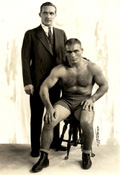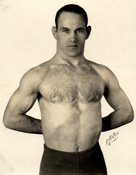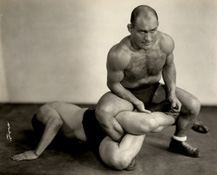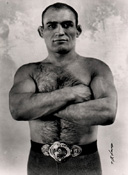Charles "Midget" Fischer
 Butternut's "Midget" Prohibition officially began on January 16, 1920, with implementation of the Eighteenth Amendment to the Constitution of the United States. Intended to reduce the consumption of alcohol and achieve an easing of the ills of society attributed to the easy availability of fermented refreshment, it instead spawned an era of illegal beverages. The national headquarters of crime elements engaged in marketing forbidden liquids was Chicago, Illinois. And it was there that Charles Fischer sought employment. In 1923 Fischer worked for Henry Pfund, driving truck and making deliveries of block ice and "beverages." Charlie excelled at both but the activities were markedly varied. Icemen of the day wore a leather shell that covered the shoulders and arms. While ice blocks were supported on that part of the anatomy it was not so for those handling barrels of liquid enjoyment. True, leather was worn but as an apron for barrels were carried across hips and thighs, supported with arm, hand and finger muscles. Chicago's most famous iceman of the day was Red Grange, University of Illinois football sensation. The name of his barrel-bearing counterpart was not well known. Not yet. The first issue of Time magazine was published on March 2nd of 1923 and future television personality Ed McMahon was born just four days later. Insulin, discovered by Canadian Dr. Frederick Banting the year before, became available for general use in April. It is now November and we find employer Henry Pfund and employee Charlie Fischer about to make a momentous delivery. A 1931 newspaper article related Fischer's recollection of that day:
He Has Not Lost a Finish, 2-Fall Match, and Now Holds Two Titles. Charlie Fischer, the 1/2-pint size Samson who holds the world middle and light heavyweight wrestling championships, was born to be a wrestler. Backed by no fanfare of publicity, no background of football or other athletic honors, and possessing only a marvelously developed physique, Fischer began wrestling in 1924--at the age of 24 years--and within a month had won the Cook County Illinois, middleweight and light heavyweight amateur titles. Within three months after he had first donned wrestling tights, the Milwaukee Midget had won second honors as a middleweight in the Olympic games tryouts. Participant in nearly 500 mat matches, Fischer never has lost a finish, 2-fall match. He also is one of the very few wrestlers ever to hold two major division titles, and the first to hold the middle and light heavyweight titles. 
 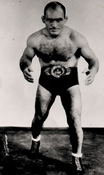 WORKS IN LUMBER CAMPS Born in Butternut, Wis., of German parents, and a member of a family of seventeen, Fischer soon developed into a husky youngster. He went into the North Wisconsin lumber camps and worked there and in the forests of the Northwest until he was 24 years old. Then he went to Chicago in quest of fortune, not realizing that there, too, fame would find him. There, one day, on a wager, he carried a
400-pound barrel unaided to the third floor of a building. Ernst
Kartge, one-time light heavyweight mat title contender, was on
the losing end of the wager with Fischer's employer, Henry
Pfund.
Kartge at that time was mat instructor at the Hebrew Institute in Chicago. Morris Rubenstein, a middleweight, was his star pupil. "I'll make the same bet on Rubenstein," he offered. Pfund snapped up the offer, escorted Fischer home and bought him a leaflet describing some of the more popular wrestling holds. "Study this, and get one of them down pat," he told Fischer. "We'll surprise Mr. Kartge." And surprise him they did, for Fischer
tossed Rubenstein on his shoulders in exactly 5 minutes 35
seconds. Fischer then was properly smitten by the bug of
wrestling ambition and joined a mat class in a Swedish gymnasium
where embryonic wrestlers worked out daily upon payment of a
50-cent-a-month fee for use of the mats. Four weeks later,
Fischer possessed the gold medals emblematic of the Cook County
middle and light heavyweight mat titles. He had
At the start of the 1924 Olympic Games
tryouts for the American team in Madison Square Garden, a
chunky, heavily muscled youngster, representing the Swedish A.C.
of Chicago, appeared as an entrant. No one there had heard of
Fischer. He waded through all opposition to the finals, and
there was declared loser on points. Three men were to be taken
in the middleweight division. In the final selection of the team
members, however, he was left behind. Granted, there are several misleading statements in the preceding article. To begin, the Fischer family would have encompassed seventeen children if stillbirths and miscarriages hadn't occurred. In addition, Charlie's age was misstated. Born on January 2, 1898, he entered organized wrestling around the time of his 26th birthday. There can be no doubt, however, of the magnitude of his amateur athletic accomplishments in five areas: 1) Within six weeks of joining the Swedish-American Athletic Club Fischer earned both the middleweight and light heavyweight amateur titles of Cook County, Illinois: 2) Both titles were garnered only after Charlie had defeated twenty-seven men in the course of a one day tournament: 3) Less than six months after entering organized wrestling Fischer finished second in the Olympic Trials, his only loss denying him the title of National Amateur Athletic Union Middleweight Wrestling Champion: 4) In well over one hundred amateur matches, the Olympic Trials loss in New York's Madison Square Garden was his only defeat: and 5) All of this was accomplished without the benefit of a coach. Throughout his life, Charlie would remember, relive, relate, resent and regret the loss in New York he considered undeserved. Having experienced bitter disappointment in losing the middleweight title on a decision and being denied participation in the 1924 "Chariots of Fire" Olympics in France, Fischer entered professional wrestling in 1925. A future opponent of racial injustice, Rev. Martin Luther King was born on January 15, 1929. Eight days earlier an opponent of athletic injustice in the form of fixed contests had turned the wrestling world upside down. Again we follow the text of the 1931 news article: He returned to Chicago, continued to train and work out daily, and in the summer of 1925 engaged in his first professional match with Jack Sperling, a ranking middleweight whom he defeated in nine minutes. Then he tackled Heinie Engle of Dubuque, Ia., who had just wrestled Johnny Meyers, the champion of the division, to a 2-hour draw. Fischer defeated Engle in seven minutes. Until the fall of 1926 Fischer engaged in nearly 150 professional matches, meeting and defeating middleweights and light heavyweights with equal ease, although at that time he weighed less than 160 pounds. Ralph Parcaut, Lou Talaber, Eddie Pope, Bobby Bylund all men who had held the middleweight crown--were defeated by Fischer. He demanded a match with Meyers, the titleholder. The event was arranged, scheduled for a Chicago arena. Meyers was injured in training and from then until 1929 refused to meet Fischer.
In 1929 the Milwaukee Midget, backed by a petition with the names of more than 5,000 admirers, presented his case to the Illinois athletic commission. The body ordered Meyers to meet Fischer and the match took place in the Broadway armory in Chicago January 7, 1929, Fischer winning a decision at the end of two hours of wrestling. Two months later he met Meyers on the same mat and won in two straight falls in less than an hour. <>Kansas City Star, Tuesday, March 3, 1931 Ed White, Fischer's former manager and the undisputed czar of wrestling promotions in Chicago, had seen to it that Johnny Meyers would not be found in the same ring as "The Wisconsin Wildcat." A comparison of the physical attributes of both men revealed some of the reasons for White's hesitance in letting Fischer have at Meyers. Unfortunately, these measurements are not complete:
Johnny Meyers was the more experienced man but Charlie Fischer had whatever advantage could be gained by being seven years the champion's junior. True, Meyers was taller, heavier, and larger in chest and waist measurements. But when one considers those muscles used to apply pressure, Fischer holds the upper hand in reach, wrist, forearm and calf measurements. Judging by photographs of the two men in similar poses, it is almost certain that "Midget" Fischer also won comparisons of biceps and thigh dimensions. There were other factors which could not be so easily quantified, and it was those that Meyers feared most. Strength, skill, speed, determination, cunning and concentration: These were Fischer's major assets. There were wrestlers as strong, as skilled and as fast. But to put all three together in the far corner made Meyers' task all the more formidable. A witness of the changing of the championship in Chicago provided hometown readers with his recollection: Emil Birkholz, former Butternut resident, but now living in Chicago, attended the wrestling match recently held in that city in which Charlie Fisher of Butternut won the decision over Johnny Meyers, and through his victory cinched his claim to the championship of the middleweight class. Mr. Birkholz's letter follows: Chicago, Illinois. Editor, Butternut Bulletin: I attended the wrestling match between Charlie (Midget) Fisher and Johnny Meyers and I would like to have the folks at home know it was some match. It was the best Chicago has witnessed for quite a number of years. For the first hour it was anybody's match. Then Charlie put on four headlocks and it looked like good bye Meyers, when like a flash he got an arm stopper hold and Charlie had to give the fall or suffer a possible dislocated shoulder and even worse. My hopes had faded just a little bit but not Charlie's, for I talked to him in the rest period and he had just as much confidence of winning as before the match started. After the rest period it was sure heart breaking for Charlie when he came back. It seemed as though every one wanted to be with the winner and Charlie got a few cheers out of the seven thousand people but Johnny who is usually booed was given cheers by at least six thousand present. The next 26 minutes were the best of any wrestling match ever put on any place. Charlie was sure out there to even things up. He had at least 7 or 8 headlocks in a row before Meyers fell into a wristlock and cross body hold for a fall. Then the whole house seemed to be for Charlie. I'll bet it was the greatest applause with the exception of the one that came later when his arm was raised as the winner, that Charlie ever received. He sure is deserving of it after being side stepped and stalled off so many times by Meyers. Charlie proved to be the man and only man that could win over Meyers in the passed 10 or 11 years. Yours Respectively, P. S. Hello to all my Butternut friends. Black Tuesday (October 29, 1929) was so named for the dark panic that gripped the nation on that day. While many households slipped into poverty as a result of unemployment and savings lost, Fischer's pace never slowed. The wrestling public may have seen a parallel in the diminutive lumberjack from the distant town in Northern Wisconsin and their own plight. If "Midget" Fischer could best bigger opponents, perhaps they, too, could regain their financial footing. Again we turn to the article from Kansas City: 
In the Kansas City American Legion mat tournament in the fall of 1929, Fischer met Billy Edwards, the then world light heavyweight champion, and defeated Edwards in two straight falls in less than an hour. Since then, Fischer, who meets Cecil Montgomery, the navy heavyweight champion, in one of the matches on Thursday night's Legion mat show in Convention hall, has been wrestling in the three upper weight divisions. Recent heavyweight victims, to whom Fischer has conceded forty and more pounds in each instance, have been Bill Heenie, Frank Davis, Roy Gillas and George Mack. Kansas City Star, Tuesday, March 3, 1931 Fischer had traveled home to Butternut in the final days of January, 1929, allowing family and friends to see him perform as the Middleweight Champion of the World. Now they would see a two-division champion in action. The match was held on the third floor of Butternut School. The room served as a classroom/study hall during school hours. With desks piled in the halls, it became an auditorium/basketball court. And, on a night in late December of '29, the site of a match with Fischer's light-heavyweight world championship at stake.
Uses all his Energies to Defeat Koch Sunday Charlie Fisher held his light heavy weight wrestling crown all right last Sunday in his match with Fred Koch of Chicago, but Charlie had to use both hands to hold the crown on. It was a great match, held in the school house of Fisher's home town. It was witnessed by the best crowd that has seen a match in Butternut at any time. Nearly 100 of the crowd was from Park Falls. Lovers of the mat game were there from Glidden, Prentice, Butternut and Park Falls, as well as other surrounding communities. Fisher weighed in at 168 and Koch at 173. When Koch first made his appearance in the ring with his bath robe on it looked like an easy set up for Fisher. But when he took the bathrobe off and the crowd noticed his splendid physique, it begin to say, "Well, maybe this bird can wrestle." Well, he could and did, to the effect that he won the first fall from Fisher in 42 minutes with a toe hold and face lock. There had been some whirlwind work just preceding the finish of the round. Fisher had clapped on a half a dozen headlocks in quick succession, and it looked as if he had Koch groggy, but somehow quick as a flash Koch had a toe hold and a face lock, and Fisher was pounding the mat in token of surrender. Fisher is a wily wrestler, and takes no unnecessary punishment. He saw that he was gone, and didn't insist that Koch put his shoulders to the mat. The second fall was different Fisher winning in ten minutes, after Koch had tried the flying tackle, which was a good deal like "carrying coals to Newcastle," because Fisher next to Gus Sonneberg has that trick down better than any man in the wrestling game. Koch's try at the tackle was quite unsuccessful, and quick as a flash Fisher resorted to the same tactics and had Koch butted Koch off the mat a couple of times, after which he was an easy prey for a double bar arm hold. Koch's shoulder was so badly injured in this fall that he was unable to resume the bout and conceded the deciding fall and the match to Fisher. Elmer Sanders the portly Sheriff of Ashland county, himself a former wrestler refereed the match. The main match was preceded by a number of preliminaries in which local Butternut boys engaged, and which Carl Benz refereed. There are a number of promising young wrestlers in and around Butternut since Charlie Fisher first made the game known to that section. One of the features of the show was the
presentation of a handsome traveling Thebag to Fisher by his
Butternut friends. In addition to the "handsome traveling bag" (which the Fischer family still has), "Midget" received another gift that required a greater sacrifice by his admirers. Although the exact date of the presentation is unknown, it was mentioned for the first time in February of 1930. |
|||||||||||||||||||||||||||||||||||||||||||||
 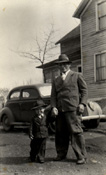 |
|||||||||||||||||||||||||||||||||||||||||||||
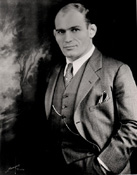
 |

